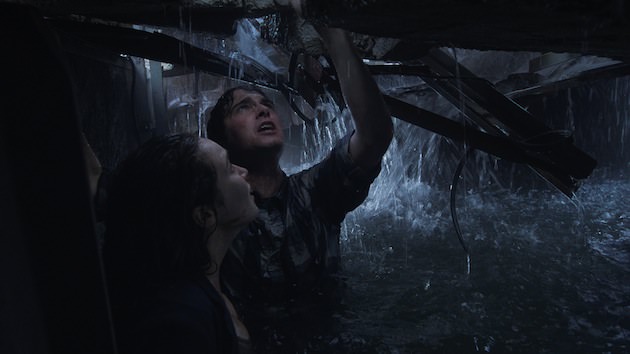How Into The Storm‘s DP Filmed in Torrential Rain & 100-mph Wind
How do you take a moderately budgeted action film that requires Biblically ferocious storms causing massive damage and make it look like money was no concern at all? With ingenious filmmaking techniques, expertise along a broad spectrum of skills, and a whole lot of problem solving is how. Into the Storm was initially contracted with the VFX house Rhythm & Hues to handle the creation of the cataclysmic tornados that are the film’s raison d’etre, but after Rhythm & Hues filed for bankruptcy protection (they’ve since found a new owner), the production lost some $3 million worth of VFX work. After receiving tax incentive help from the state of Michigan, which helped bring down the cost of the physical production down, the Storm crew masterfully plotted out just about every seemingly random thing you see on screen—from the trajectory of the massive tornados and the final resting spot of airborne vehicles to the twisted metal debris scattered about a ruined paper factory—so that they could maximize their time to create their storm-savaged world. While they used 15 different effects houses to get the 600 VFX shots they needed, it was thanks in large part to the ingenuity of filmmakers like cinematographer Brian Pearson who figured out ways to keep the production moving even when new hurdles kept presenting themselves.
We spoke to Pearson about how he and the crew managed to overcome those hurdles and create a truly thrilling ride, including turning a sunny summer in Michigan into Oklahoma in the midst of successive natural disasters, kept his camera equipment dry under the torrential downpour from the rain bars over his head for days on end, and why nitrogen can be a camera operator's best friend.
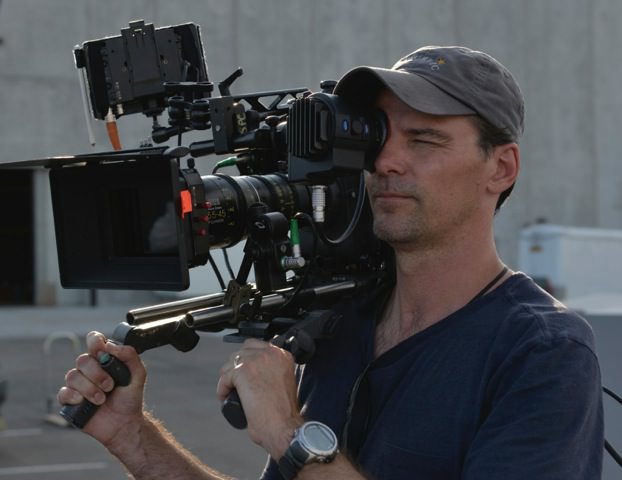
How many of the sequences were storyboarded? Can you walk us through your process with director Steven Quale?
When we started, Steve made a number of different storyboards, then had animated computer boards made, called animatics. The biggest sequences of the tornados were all pre-visualized with computer design programs that animated, in pretty good detail, the locations of the characters, vehicles and the tornados. Scott built a number of those storyboards for the bigger sequences. Then as we location scouted, we found the various settings and we sent those images to the animatic company, who would then retrofit the details into our chosen location.
How much physical blocking of the scenes did you?
Scott and I went to locations and talked through, in detail, the various beats of the sequences, and we marked the places in our walk-through where the tornados would touch down and the cars would fall. Everything was very blocked out, the beats are very specific, and it’s a matter of finding a specific location and honing in on where things are going to happen.
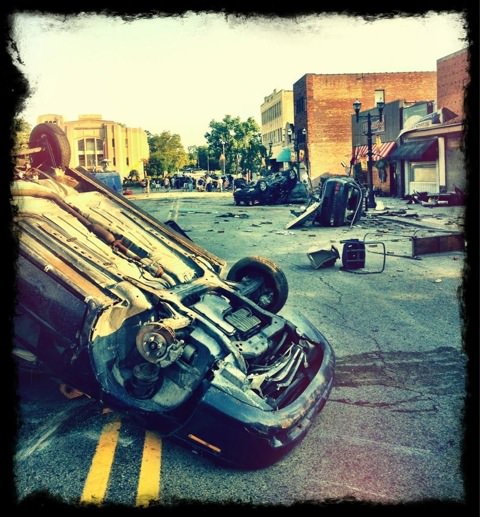
One of the many really difficult technical challenges you had was filming a movie that needs to look stormy for almost the entire story, yet you had to film in Michigan in the summer, where it was more or less consistently sunny and beautiful during production. How’d you pull that off?
We made a very big, expensive decision, which was to use construction cranes to cover the sun and the actors, and shoot under the shade created by these 40 by 60 trusses we attached to the cranes. Then we had VFX erase the sun in the background. We had to be very specific about it all because the cranes do not move quickly.
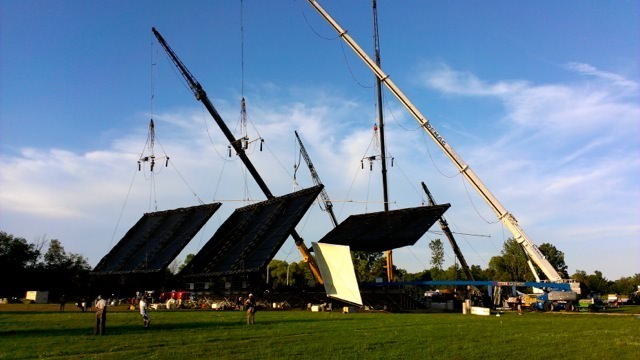
So you’re essentially shooting under these massive shrouds?
Yeah, they’re very large construction cranes with a 40 by 60 truss, which is made of a heavy material that can withstand wind. The truss was made of charcoal grid cloth. DPs usually use a white grid cloth, so you get this creamy, pretty soft back light, but in a storm, when the clouds are dark, you wouldn’t want those highlights, so I ordered a sample of a bunch of different densities of cloth, from solid to lighter ones, and we found that a deep dark charcoal let in just the right amount of light to allow the reflections on the water, vehicles, and skin. It was a very important decision. I had to customize this cloth, they manufactured four of them for us, and we had an entire rigging team whose job was to set up these construction cranes and the trusses and control them all day long to blot out the sun. The cranes take an hour or two to move and break down, and when you’re shooting a film where time is so important, we had to commit to knowing exactly where to put that crane at the beginning of the day.
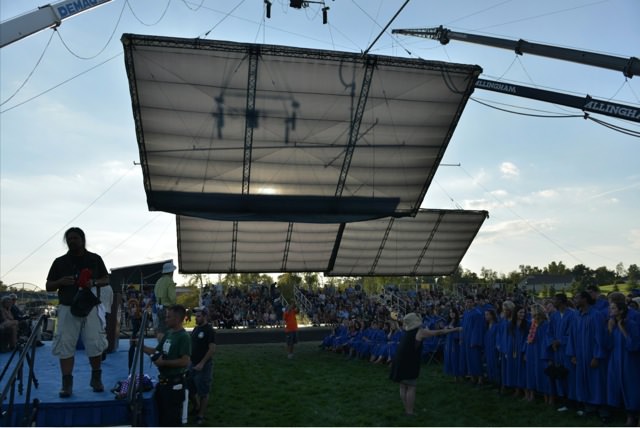
How many cranes did you have for the shoot?
We had three 40 by 60 cranes, and then we had another four or five 30 by 30s and 20 by 20s, and those more mobile cranes were used to fill in little areas. So the big cranes were like rollers and the 30s by 30s were like paint brushes. We were constantly moving and adjusting the cranes to match the movement of the sun, and the given area where the actors were standing which would change from set up to set up. And all of that was just to generate the look of the cloudy day! So this became our process for a third of the movie.
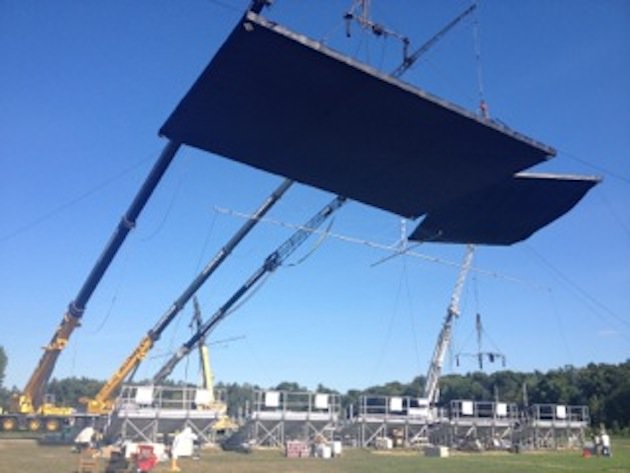
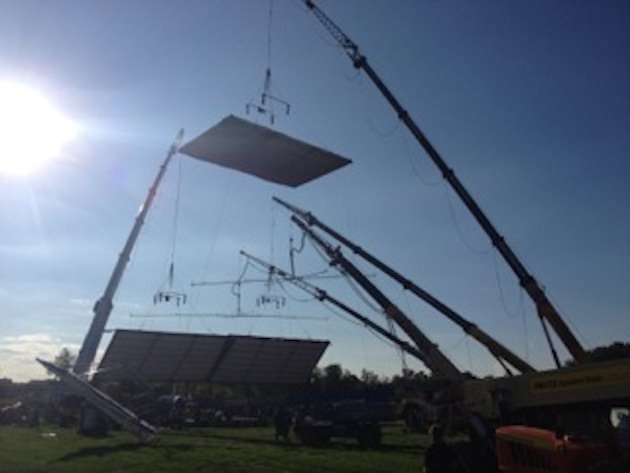
Walk us through your typical day of filming.
We would usually start around 8 am, and then Steve declared at one point that once the sun sets, you have this pocket of time that has a shady look to it, so the second part of the plan was to shoot from 8am until around 5pm, then stop so we could prepare to shoot a whole sequence, in long uninterrupted takes, at dusk. So we would stop production at five and start to rehearse these long, complicated one-take wonders with the camera, knowing that once the sun set we had about 40 minutes at the most. We used the Arri Alexa camera and the Alexa M, which are smaller, handheld cameras, and they gave us a good, long duration for dusk period that we could shoot. So it was closer, tighter shots during the day and longer, one-take shots in the dusk.
Another element of turning Michigan in the summer into Oklahoma during a storm is you were actually producing both the wind and the rain. What is it like filming under those conditions?
There’s definitely a level of complexity when we add multiple 100-mph fans and more construction cranes with 100-feet long rain bars 80-feet up in the air dumping water on cast and crew. It’s real chaos when you can’t hear anything and you’re being soaked. When the cameras rolled all we heard was the sound of fans roaring and water running, so it really became a certain amount of planned chaos. One of the difficult things we faced was keeping water off the lens and keeping the cameras dry. Our camera team worked really hard to figure out a way to keep filming once water hit the cameras.
How did they do that?
Compounding the problem was the fact the water coming out of the rain bars was really cold, and the cameras are really warm, so the minute the water hit the cameras, the lens would fog up immediately. So not only did we have to keep the water off the front of the lens, we also had to deal with the fogging problem. To handle the water on the lens, we used this product called the eliminator spray deflector, which is basically a piece of glass on the front of the camera that would spin at 5,000 rpms, which is very fast and incredibly loud, by the way, and it would instantly whisk the water away by centrifugal force from the lens. Then the way we kept the lens from fogging was we had a very small copper tube put just inside the back of the glass of the eliminator with tiny holes in it, and it would spray a curtain of nitrogen on the back side of the glass on the spray deflector, and the nitrogen would cool the back side of the lens glass, as nitrogen is a very dry gas, and it cooled the glass enough that when the cold water hit the front of the eliminator, the backside of the glass wouldn’t fog.
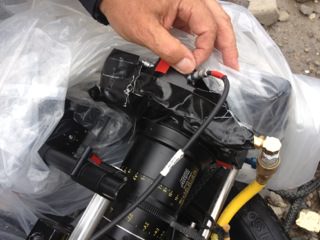
How did you manage to have all of this secondary equipment running behind and in front of your camera and still film?
Well, we kept the nitrogen flowing through the copper tube via these 50-foot long hoses that were connected to the nitrogen tanks, which were twice the size of a scuba tanks, and the tubes are all secured to the camera. We basically had the camera operator holding the camera and then a backend recording system for the Alexa M that’s carried by the dolly grip, then we had a third person with the nitrogen tank on a cart that could roll around so that the operator could move. So this ungainly octopus of people would follow the operator around while they shot in these very harsh conditions. And because the fans and the rain bars made it impossible to communicate, we could only speak through hand signals.
And what are you all wearing throughout this ordeal to stay dry and somewhat sane?
Everyone’s wearing ear protection, goggles and rain gear. But the actors could only wear tiny ear plugs, even though they’re working in extremely high winds and torrential rain. So while the rest of the team is in rain gear, the actors are in their wardrobe with no protection for their eyes. These were very long days for them.
Was there a particular sequence you found most difficult to film?
The most daunting sequence was the one in which Donnie (Max Deacon) and Kaitlyn (Alycia Debnam Carey) are trapped in the paper factory. Although the rest of the movie had these huge logistical sequences, this one was tough from the cameraman’s perspective because we’re in water, in a very small space, and the water was filling up higher and higher. And it was one of those sequences which was on that fine line of how dark can you go where you can still see faces, but it looks natural, while creating a sense of claustrophobia. You need to be able to read the performances, see the tears on their faces, but still make it feel real and naturalistic. Our production designer David Sandefur built a beautiful tank set on a raised platform, and we put lightweight debris in pieces, it was all pre designed but it looks totally haphazard. The debris had to be specifically designed so we could free the actors later on with certain pieces that could move away, so there was nothing random about it. It was all pre-planned on how the light would come through, how the water would rush through, and I had a number of different water proof lights and a couple of lights in bags, as well as some underwater kino flows. We also used LED lights that were dimmable that put just the right amount of light on their faces. It all felt very real, even though we could open a hatch and get out, it really felt like we were trapped, water filling in, so it was just a difficult couple of days.
